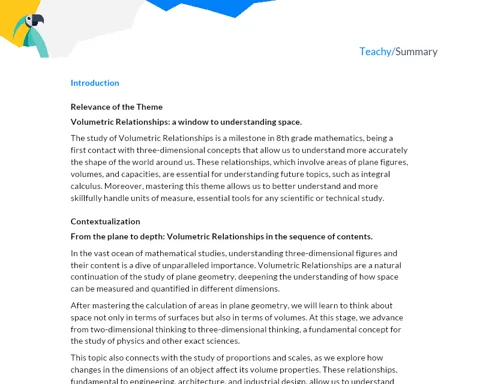Introduction
Relevance of the Topic
Function: Codomain and Image is one of the fundamental pillars of algebra, an essential topic that is at the heart of all subsequent mathematical studies. Learning and understanding this topic provides the key to unlocking a world of mathematical application in many other disciplines, from computer science to engineering.
- Relevance in Mathematics: The concept of function is one of the cornerstones of mathematics. Understanding codomain and image deepens this notion, and without it, many subsequent topics become inaccessible or incomplete.
- Relevance in Daily Life: Functions are present in many contexts of daily life, from weather forecasting to personal finance. Understanding the image and codomain of a function allows for better interpretation and application of information in these contexts.
Contextualization
Within the global Mathematics curriculum, the study of Functions and their domains, codomains, and images occurs at a crucial stage in the first year of High School. This is the point where we move from more abstract mathematical concepts to more practical and real applications. Students already have a solid understanding of numbers and operations, have dealt with expressions and equations, and are now ready to explore the fascinating possibilities that Functions offer.
- Previous Points: Functions are introduced after the study of expressions and equations, allowing students to use their previous knowledge to build a deeper understanding of Functions.
- Subsequent Points: A deep understanding of Functions, particularly the concepts of codomain and image, is essential for future topics, such as function composition, function properties, inverse functions, and much more. These topics will be included in the next modules and sections of the curriculum. Therefore, a solid understanding of these concepts is crucial.
Theoretical Development
Function
A Function is a correspondence between two sets, usually called Domain (set of input values) and Codomain (set of output values). Each element in the domain is related exactly to one element in the codomain. The function is denoted by f(x), where f is the function rule and x is the input element.
f(x): Function notation, wherefdenotes the function andxis the input value.- Domain: Set of all possible values of
x. - Codomain: Set of all possible values of
f(x).
Codomain and Image
Understanding the concepts of Codomain and Image is a natural extension of the function.
- Codomain: It is the set of all possible output values (typically represented by
y) of a function. In other words, these are all the values that the function can, in theory, produce, regardless of whether all these values are actually produced. The codomain is a subset of the setY. - Image: It is the set of all output values (i.e.,
y), which a function actually produces for the input values of the domain.
Graphical Representation
- Function graph: A visual representation of a function. The domain is represented on the
xaxis, the codomain on theyaxis, and the relationships between the two are shown by the curves on the graph. - Interception: In the graph of a function, the interception of the graph with the
yaxis represents the value of the codomain, i.e., the set ofyvalues for which there are points on the graph. - Usage Form: When interpreting a function graph, we can easily identify the codomain (
yaxis), the image (theyvalues associated with the domain points), and whether the function is injective (noyis repeated) or surjective (allyare used).
Detailed Summary
Relevant Points:
- Functions and Representations: Functions are correspondences between two sets, the domain and the codomain. They are represented by
f(x), wherefis the function rule andxis an element of the domain. - Codomain: It is the set of all possible output values (typically represented by
y) of a function. Eachyin the codomain has a correspondingxsomewhere in the domain. - Image: It is the set of all output values (i.e.,
y) that a function actually produces for the input values of the domain. The image is a subset of the codomain. - Graphical Representation: In the graph of a function, the domain is represented on the
xaxis and the codomain (and the image) on theyaxis. The relationships between the two sets are represented by the curves on the graph.
Conclusions:
- Nature of Functions: Functions establish a direct and unique relationship between elements of the domain and the codomain. This means that for each element in the domain, there is one and only one element in the codomain.
- Visual Representation: The graph of a function provides a useful visual representation for understanding and analyzing the concepts of codomain and image.
- Practical Application: Understanding codomain and image is essential in many areas of life and mathematics, from solving complex problems to creating predictive models.
Exercises:
- Exercise 1: Given the function
f(x) = x^2, determine the codomain and the image. Graphically represent the function. - Exercise 2: Consider the function "increases by 3 units for every 2 units in the domain". Write the function in
f(x)notation, define the domain and codomain, and draw the graph. - Exercise 3: For the function
f(x) = √(x+1), find the largest possible subset of the codomain off. Graphically represent the function and explain the result.



